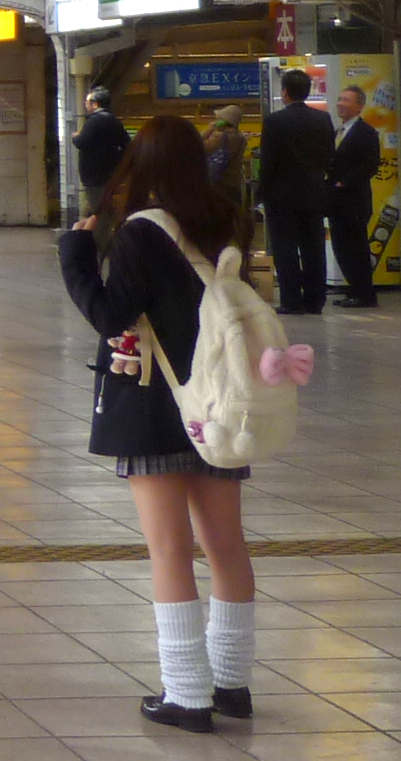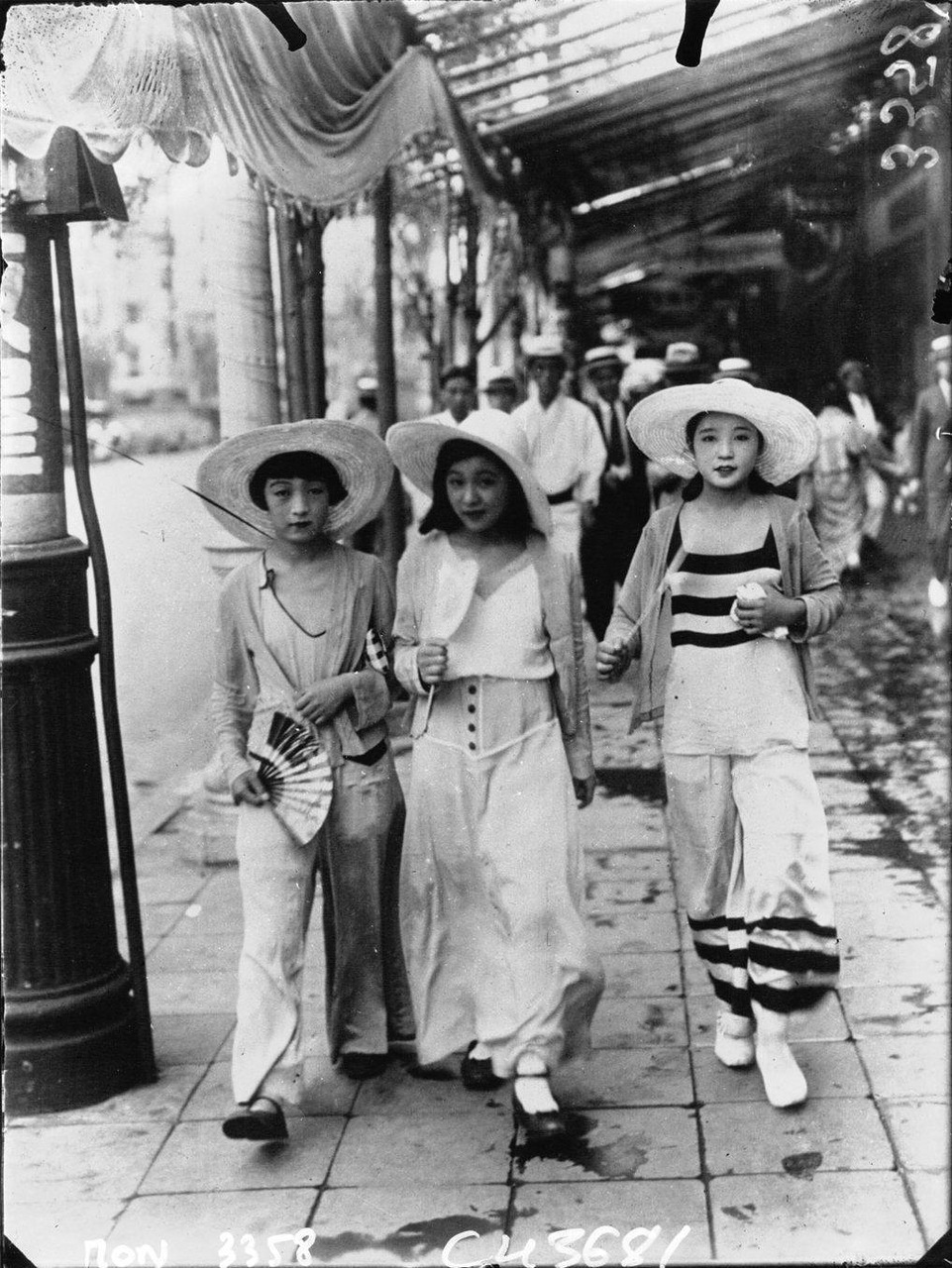|
Kogyaru
is a Japanese fashion culture that involves schoolgirls wearing an outfit based on Japanese school uniforms (or their actual uniforms) but with very short skirts. The short skirts are worn irrespective of the season. The girls may also wear loose socks and scarves, and have dyed hair. The word ''kogal'' is anglicized from , a contraction of ("high school gal"). The girls refer to themselves as ("gals"), although this word is applied to several other fashion looks as well. Aside from the miniskirt or microskirt, and the loose socks, kogals favor platform boots, makeup, and Burberry check scarves; some kogals carry accessories considered kawaii or cute. They may also dye their hair brown and get artificial suntans. They have a distinctive slang peppered with English words. They are often, but not necessarily, enrolled students. Centers of kogal culture include the Harajuku and Shibuya districts of Tokyo, in particular Shibuya's 109 Building. Pop singer Namie Amuro promot ... [...More Info...] [...Related Items...] OR: [Wikipedia] [Google] [Baidu] |
Gyaru
( ja, ギャル) , is a Japanese fashion subculture. The term ''gyaru'' is a Japanese transliteration of the English slang word . The term for was introduced in Japan by the American jeans company ''Lee'', who introduced a new line of jeans to their brand ''Wrangler''. When the women's jeans line 'GALS' was released in the 1970s; the term had been quickly used outside of its original branding and was adopted to describe the fashion by 1972. subculture was at its peak during the Heisei era. It had a large influence on Japanese fashion and its economy, its international economy, and its global soft power across the world through Cool Japan such as in Southeast Asia and internationally. Multiple brands branched out before eventually declining due to financial instability and changes in its target demographic. The terms usage peaked in the early 2000s and has gradually declined since. This decline has been attributed to shifts in magazine industry, the exaggeration of th ... [...More Info...] [...Related Items...] OR: [Wikipedia] [Google] [Baidu] |
Japanese School Uniform
The Japanese school uniform is modeled in appearance similar to that of the European-style naval uniforms. It was first used in Japan in the late 19th century, replacing the traditional kimono. Today, school uniforms are common in many of the Japanese public and private school systems. The Japanese word for this type of uniform is . History The majority of Japan's junior high and high schools require students to wear uniforms. The Japanese school uniform is not only a symbol of youth but also plays an important role in the country's culture, as they are felt to help instill a sense of discipline and community among youth. There are many types of uniforms that range from standard to unique ones varying in the ensembles used. Japanese school uniforms have been around for 150 years. Originally students just wore standard everyday clothes to school; kimono for female students, with for male students. During the Meiji period, students began to wear uniforms modelled after Weste ... [...More Info...] [...Related Items...] OR: [Wikipedia] [Google] [Baidu] |
Conspicuous Consumption
In sociology and in economics, the term conspicuous consumption describes and explains the consumer practice of buying and using goods of a higher quality, price, or in greater quantity than practical. In 1899, the sociologist Thorstein Veblen coined the term ''conspicuous consumption'' to explain the spending of money on and the acquiring of luxury commodities (goods and services) specifically as a public display of economic power—the income and the accumulated wealth—of the buyer. To the conspicuous consumer, the public display of discretionary income is an economic means of either attaining or of maintaining a given social status. The development of Veblen's sociology of conspicuous consumption also identified and described other economic behaviours such as invidious consumption, which is the ostentatious consumption of goods, an action meant to provoke the envy of other people; and conspicuous compassion, the ostentatious use of charity meant to enhance the reputati ... [...More Info...] [...Related Items...] OR: [Wikipedia] [Google] [Baidu] |
Masato Harada
is a Japanese film director, film critic, and sometimes an actor; he is best known to foreign audiences as Omura in ''The Last Samurai'' and as Mr Mita in ''Fearless''. In both his acting roles he portrayed the villain who wants Japan to westernize under the Meiji Restoration in the meantime trying to remove the old ways. Early life Harada was born in Numazu, Shizuoka and graduated from Higashi High School. In 1972 he went to London to learn English. He then attended Tokyo College of Photography and Pepperdine University, where he spent number of years training as a filmmaker. He married journalist Mizuho Fukuda in 1976. Career Harada made his directorial debut in 1979. He collaborated and showcased his works in Europe and US and worked as an English to Japanese subtitle translator for number of American films showing in Japan. As an actor, he appeared in Edward Zwick's ''The Last Samurai'' in 2003. and Ronny Yu's ''Fearless'' in 2006. Style and influences In a 2001 interview, ... [...More Info...] [...Related Items...] OR: [Wikipedia] [Google] [Baidu] |
Bounce Ko Gals
is a 1997 Japanese crime drama film written and directed by Masato Harada. Its alternative English-language titles are ''Call Girls'' and ''Leaving''. Filmed in somewhat of a documentary style , it follows the course of three girls for a day and a night In the popular district of Shibuya in Tokyo. The main characters are : Jonko (Hitomi Sato (actress), Hitomi Satô), who runs a group of high-school girls involved in paid dating (in Japanese Enjo kōsai, Enjo Kôsai 援助交際) , Raku (Yasue Sato) who is a high-schooler and also a street dancer; and Lisa ( Yukiko Okamoto (actress), Yukiko Okamoto) who is a student , who worked for a year, saving enough money and a plane ticket , to go study in New York City, New York. Cast * Hitomi Satō (actress), Hitomi Satō as Jonko * Yasue Sato as Raku-chan * Yukiko Okamoto (actress), Yukiko Okamoto as Risa * Kōji Yakusho as Ōshima * Jun Murakami as Sap * Shin Yazawa as Maru * Kaori Momoi as Saki * Maori as Kuji * Kaitō Ren as Shingo * Y ... [...More Info...] [...Related Items...] OR: [Wikipedia] [Google] [Baidu] |
Enjo Kōsai
is a type of transactional relationship similar to the western equivalent being a call girl of Sugaring. It is the Japanese language term for the practice of older men giving money and/or luxury gifts to attractive young women for sexual favors. The female participants range from school girls (or JK business) to housewives. The term is often translated as "compensated dating" or "subsidized dating". The opposite case of women paying men, , is not a documented social phenomenon, but fraudulent solicitations from fictive women offering to pay for sex is a common tactic in phishing emails. Definition The most common connotation of the term enjo-kosai in Japan is that it is a form of child prostitution whereby participating girls sell their bodies in exchange for designer goods or money. However, some organizations and writers have argued that enjo-kōsai is distinct from prostitution, and can include just spending time together for compensation. Some women's centers in Japa ... [...More Info...] [...Related Items...] OR: [Wikipedia] [Google] [Baidu] |
AKB48 20090703 Japan Expo 55
AKB48 (pronounced ''A.K.B. Forty-Eight'') is a Japanese idol girl group named after the Akihabara (''Akiba'' for short) area in Tokyo, where the group's theater is located. AKB48's producer, Yasushi Akimoto, wanted to form a girl group with its own theater and performing daily so fans could always see them live (which is not the case with usual pop groups giving occasional concerts and seen on television). This "idols you can meet" concept includes teams which can rotate performances and perform simultaneously at several events and "handshake" events, where fans can meet group members. Akimoto has expanded the AKB48 concept to several girl groups in Mainland China, Japan, Indonesia, Thailand, Taiwan and the Philippines. AKB48 have been characterized as a social phenomenon. They are among the highest-earning musical acts in Japan, and are the fifth-best-selling girl group worldwide. For example, their 2012 sales from record and DVD/Blu-ray releases reached $226 million, ea ... [...More Info...] [...Related Items...] OR: [Wikipedia] [Google] [Baidu] |
Happie Nuts
''Happie Nuts'' was a gal fashion magazine published monthly in Japan by Inforest Publishing. Targeted at women in their late teens and early 20s, ''Happie Nuts'' was highly oriented toward the style of ''oneh-gal'' ("o-neh-san gal", lit. "older-sister gal") and dark-skin."Happie Nuts" , ''Women's Fashion Magazine Guide'' Based in Tokyo, it was in circulation between 2004 and 2016. History ''Happie Nuts'' was first published in November 2004"Happie Nuts", ''Model Press'' as the successor to ''Happie'', a fashion magazine targeted at female teenagers. ''Happie Nuts'' spawned its special edition, ''Koakuma & Nuts'', in October 2005, whi ... [...More Info...] [...Related Items...] OR: [Wikipedia] [Google] [Baidu] |
Kawaii
''Kawaii'' is the culture of cuteness in Japan. It can refer to items, humans and non-humans that are charming, vulnerable, shy and childlike.Kerr, Hui-Ying (23 November 2016)"What is kawaii – and why did the world fall for the ‘cult of cute’?", ''The Conversation''. Examples include cute handwriting, certain genres of manga, anime, and characters including Hello Kitty and Pikachu. The cuteness culture, or ''kawaii'' aesthetic, has become a prominent aspect of Japanese popular culture, entertainment, clothing, food, toys, personal appearance, and mannerisms. Etymology The word ''kawaii'' originally derives from the phrase ''kao hayushi'', which literally means "(one's) face (is) aglow," commonly used to refer to flushing or blushing of the face. The second morpheme is cognate with ''-bayu'' in '' mabayui'' (眩い, 目映い, or 目映ゆい) "dazzling, glaring, blinding, too bright; dazzlingly beautiful" (''ma-'' is from ''me'' "eye") and ''-hayu'' in ''omohayui'' ... [...More Info...] [...Related Items...] OR: [Wikipedia] [Google] [Baidu] |
Popteen
''Popteen'' is a monthly teenage fashion magazine published by the ''Kadokawa Haruki Corporation'' in Japan. The first issue was published on 1 October 1980 by ''Kadokawa Shoten''. Later issues were published by ''Asuka Shinsha'' who bought the magazine for 200 million yen. In 1994 the magazine was bought by the Kadokawa Haruki Corporation for 600 million yen, and has since become its flagship publication. ''Popteen'' is one of Asia's top fashion magazines. The magazine is published in Japan, Taiwan, and Thailand, and has launched a web presence in the United States. Both Ayumi Hamasaki and Kumiko Funayama have been featured on the cover 19 times, Hamasaki first appearing in 2000 and Funayama in 2008. Other artists who have appeared on the cover include Kumi Koda and Namie Amuro, as well as foreign artists like Avril Lavigne, Britney Spears, Fergie, and Gwen Stefani. The magazine is famous for including 'doku-moderu' (読者モデル) where the readers of Popteen are able to ... [...More Info...] [...Related Items...] OR: [Wikipedia] [Google] [Baidu] |
Modern Girl
(also shortened to ) were Japanese women who followed Westernized fashions and lifestyles in the period after World War I. were Japan's equivalent of America's flappers, Germany's , France's , or China's (). By viewing through a Japanese versus Western lens, the nationalist press could use the modern girl archetype to blame such failings as frivolity, sexual promiscuity, and selfishness on foreign influence.''The Gender/Sexuality Reader: Culture, History, Political Economy'', edited by Roger N. Lancaster and Micaela Di Leonardo, pp. 493-494 The period was characterized by the emergence of working class young women with access to money and consumer goods. Using aristocratic culture as their standard of Japaneseness, the critics of the modern girl condemned her working class traits as "unnatural" for Japanese. Modern girls were depicted as living in the cities, being financially and emotionally independent, choosing their own suitors, and apathetic towards politics. [...More Info...] [...Related Items...] OR: [Wikipedia] [Google] [Baidu] |

.jpg)




